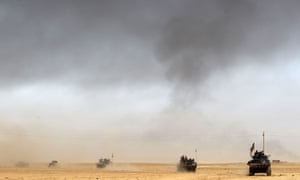By Paul Torpey, Pablo Gutiérrez and Paul Scruton
In June 2014, when the leader of Isis, Abu Bakr al-Baghdadi, declared a global caliphate, he did it from Mosul, Iraq’s second city. Isis rapidly expanded its territory in Iraq and Syria throughout that year, but has since been gradually pushed back, partly due to US-led airstrikes. Losing Mosul now could spell the end of the jihadi group’s ability to control large swaths of Iraq.
The long-awaited operation to take back Mosul began on 16 October, involving a coalition of more than 30,000 troops drawn from Iraqi army forces, Kurdish peshmerga fighters and Shia militias, supported by airstrikes from a US-led coalition. Turkish forces are also involved despite Iraqi government opposition.
Around 6,000 Isis fighters could be holed up in the city among more than a million civilians. It was agreed that only the Iraqi army would enter Mosul, due to fears its mainly Sunni inhabitants would see the Kurdish and Shia forces as too partisan.
 FacebookTwitterPinterest Iraqi forces advance towards Shura on the first day of the battle for Mosul. Photograph: Ahmad Al-Rubaye/AFP/Getty Images
FacebookTwitterPinterest Iraqi forces advance towards Shura on the first day of the battle for Mosul. Photograph: Ahmad Al-Rubaye/AFP/Getty Images
Week one: multi-pronged attack begins
After one week, progress was made to the north, south and east of Mosul despite Isis using a variety of defensive tactics. Advancing forces faced roadside bombs, dug-in snipers, fleets of suicide car bombs and oil fire haze. The jihadis also launched diversionary attacks, most significantly in Kirkuk. It was also reported that Isis fighters were forcing people from the countryside into the city to use as human shields. Most progress was made east of the city, where Iraqi forces took the baton from the peshmerga who overwhelmed several villages in the first few days of fighting. A southern push by Iraqi army troops and Shia militias lagged behind the faster-moving eastern axis.
Week two: city limits reached
Iraqi special forces reached Mosul’s eastern edge on 31 October after just over two weeks of fighting along the main Irbil road. Footholds were established in districts such as Gogjali and Karama before the westward offensive resumed on 4 November in the face of heavy Isis resistance. Advancing troops are expected to face a brutal street fight in heavily mined terrain, with booby-trapped bridges and Isis fighters concealed in tunnels. This may yet extend the operation’s length to the months forecast in many initial estimates.
Week six: awaiting a breakthrough
Anti-Isis forces have effectively surrounded Mosul after more than six weeks of fighting but most observers expect the battle to last into 2017. The only Iraqi units inside the city are making slow progress in eastern districts, where Isis forces are fighting hard in areas where large numbers of civilians are still present. About 70,000 refugees are living in camps mainly to the north-east of Mosul but their numbers could swell if conditions deteriorate further inside the city. Fighting has cut off water supplies for about 650,000 people and the UN has said a siege-like situation is developing. Food supplies have dwindled since Shia militia cut off the main corridor to Isis territory in Syria but the Iraqi government has discouraged them from taking the strategic town of Tel Afar, which may have raised sectarian tensions with its mainly Turkoman residents.
Week 14: Iraqi forces near to splitting city
A pincer movement by the Iraqi government’s Counter Terrorism Service is aiming to clear Isis fighters from the east bank of the river Tigris. Elite CTS forces seized control of the large Mosul University complex, which Isis fighters used as a base, on 15 January. Meanwhile other units have pushed north along the river after establishing their first bridgehead on 8 January. The offensive was effectively relaunched at the end of 2016 when troops from other positions were redeployed, along with US special forces, to bolster the main lines of attack in east Mosul. This enabled the CTS to advance after struggling for weeks to move beyond suburbs reached earlier in the operation.
Iraqi forces now control the eastern side of three bridges over the Tigris but none are currently operational. All river crossings were partially destroyed by US-led airstrikes aimed at hampering Isis logistics but will now need repairing for an assault on the densely populated west bank where heavy Isis resistance and several more months of fighting likely awaits.
No comments:
Post a Comment